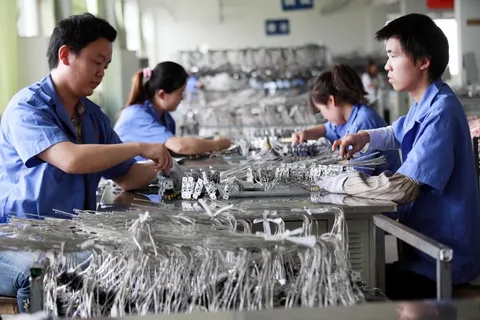In recent decades, China has emerged as a global manufacturing powerhouse, producing various products for industries ranging from electronics to textiles. However, beyond the sheer scale of production, what sets Chinese manufacturing apart is its evolving capacity for innovation.
This article looks at how China’s manufacturing landscape has shifted from primarily focused on mass production to becoming a hub for cutting-edge product development. It will explore five key aspects driving this transformation and how businesses can tap into this formidable resource.
Table of Contents
Technological advancements in manufacturing
One of the pivotal factors propelling China to the forefront of global manufacturing innovation is its rapid adoption of advanced technologies. Chinese factories invest heavily in automation, artificial intelligence, and robotics, increasing efficiency and precision across production lines. This tech-driven approach revolutionizes traditional manufacturing processes, enabling businesses to create complex products with unparalleled accuracy.
Chinese manufacturers actively engage with emerging technologies like 3D printing, nanotechnology, and IoT (Internet of Things). This convergence of cutting-edge tech and manufacturing prowess has opened up new frontiers for product development.
Ecosystem collaboration and clustering
China’s manufacturing prowess is about individual factories and an entire ecosystem that fosters collaboration and knowledge-sharing. Industrial clusters in cities like Shenzhen, Dongguan, and Suzhou have emerged as vibrant innovation hubs. These clusters bring together manufacturers, suppliers, research institutions, and startups, creating a fertile ground for cross-pollination of ideas and expertise.
This collaborative environment encourages rapid iteration and co-creation, enabling businesses to tap into vast resources. For instance, a startup developing a new electronic component can easily find specialized manufacturers, designers, and R&D facilities within the same cluster, streamlining the product development cycle.
Customization and agile manufacturing
The days of one-size-fits-all manufacturing are long gone. Chinese factories have honed their ability to customize products on a massive scale. Advanced production techniques and flexible supply chains allow for rapid changes in product specifications, accommodating the diverse needs of global markets.
This agility is particularly valuable for businesses engaged in industries with rapidly evolving consumer demands, such as fashion, electronics, and consumer goods. The ability to quickly adjust production lines based on real-time market feedback empowers companies to stay ahead of the curve, maintaining a competitive edge.
Emphasis on sustainable practices
China’s manufacturing landscape is undergoing a significant transformation towards sustainability. Recognizing the environmental impact of mass production, many Chinese factories are embracing eco-friendly practices. From implementing renewable energy sources to reducing waste through advanced recycling methods, sustainability is now a core consideration in the manufacturing process.
Businesses can align their product development with global environmental goals by partnering with Chinese manufacturers committed to sustainability. This fulfills corporate social responsibility and resonates powerfully with eco-conscious consumers, creating a market advantage.
Global reach and supply chain integration
China’s extensive network of suppliers and logistics capabilities provides unparalleled access to global markets. With well-established trade routes and distribution channels, businesses can seamlessly navigate the complexities of international trade. This integrated approach to supply chain management ensures that products can reach consumers worldwide in a timely and cost-effective manner.
By leveraging China’s robust supply chain infrastructure, businesses can focus on what they do best – innovating and developing products. This integration of supply chain management with product development streamlines operations, ultimately improving efficiency and competitiveness in the global market.
Government support and policy initiatives
China’s government is pivotal in fostering a conducive environment for manufacturing innovation. They have actively promoted research and development through strategic policies and initiatives, offering incentives for businesses to invest in cutting-edge technologies. This support extends to tax breaks, grants, and subsidies, encouraging companies to pioneer new approaches to product development.
The government’s emphasis on education and skill development has led to a highly skilled workforce well-versed in the latest manufacturing technologies. This talent pool is valuable for businesses looking to engage in complex and innovative product development.
Intellectual property protection and innovation
One critical aspect of China’s evolving manufacturing landscape is its growing commitment to intellectual property (IP) protection. Concerns over IP theft were prevalent in the past, but recent years have witnessed substantial improvements in legal frameworks and enforcement. This shift has bolstered confidence among domestic and international businesses to invest in research and development within China.
With more robust safeguards, companies can collaborate with Chinese manufacturers without the fear of compromising their proprietary technologies or designs. This, in turn, has led to a surge in joint ventures and technology transfers, fostering a dynamic environment where innovative ideas flow seamlessly between partners and they can discover whether ODM vs OEM would be the most cost effective option. This newfound trust in IP protection is paving the way for groundbreaking collaborations, reshaping industries, and pushing the boundaries of what’s possible in product development.
At the end of the day
China’s manufacturing landscape is no longer just about mass production; it’s a hotbed of innovation and technological advancement. By tapping into this dynamic ecosystem, businesses can unlock a wealth of opportunities for product development. From leveraging advanced technologies to benefiting from collaborative clusters, the potential for innovation at scale is boundless. Embracing this evolving landscape enables companies to stay competitive and drive forward the future of global product development.

